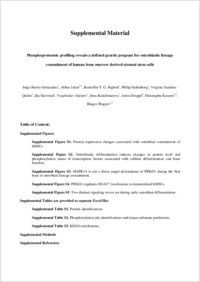Phosphoproteomic profiling reveals a defined genetic program for osteoblastic lineage commitment of human bone marrow–derived stromal stem cells
- Barrio-Hernandez, Inigo Department of Biochemistry and Molecular Biology, University of Southern Denmark, Odense M, Denmark
- Jafari, Abbas Department of Endocrinology and Metabolism, University Hospital of Odense and University of Southern Denmark, Odense C, Denmark
- Rigbolt, Kristoffer T.G. Department of Biochemistry and Molecular Biology, University of Southern Denmark, Odense M, Denmark
- Hallenborg, Philip Department of Biochemistry and Molecular Biology, University of Southern Denmark, Odense M, Denmark
- Sanchez-Quiles, Virginia Department of Biochemistry and Molecular Biology, University of Southern Denmark, Odense M, Denmark
- Skovrind, Ida Department of Biochemistry and Molecular Biology, University of Southern Denmark, Odense M, Denmark
- Akimov, Vyacheslav Department of Biochemistry and Molecular Biology, University of Southern Denmark, Odense M, Denmark
- Kratchmarova, Irina Department of Biochemistry and Molecular Biology, University of Southern Denmark, Odense M, Denmark
- Dengjel, Jörn Department of Biology, University of Fribourg, Switzerland
- Kassem, Moustapha Department of Endocrinology and Metabolism, University Hospital of Odense and University of Southern Denmark, Odense C, Denmark
- Blagoev, Blagoy Department of Biochemistry and Molecular Biology, University of Southern Denmark, Odense M, Denmark
-
01.01.2020
Published in:
- Genome Research. - 2020, vol. 30, no. 1, p. 127-137
English
Bone marrow–derived mesenchymal stem cells (MSCs) differentiate into osteoblasts upon stimulation by signals present in their niche. Because the global signaling cascades involved in the early phases of MSCs osteoblast (OB) differentiation are not well-defined, we used quantitative mass spectrometry to delineate changes in human MSCs proteome and phosphoproteome during the first 24 h of their OB lineage commitment. The temporal profiles of 6252 proteins and 15,059 phosphorylation sites suggested at least two distinct signaling waves: one peaking within 30 to 60 min after stimulation and a second upsurge after 24 h. In addition to providing a comprehensive view of the proteome and phosphoproteome dynamics during early MSCs differentiation, our analyses identified a key role of serine/threonine protein kinase D1 (PRKD1) in OB commitment. At the onset of OB differentiation, PRKD1 initiates activation of the pro-osteogenic transcription factor RUNX2 by triggering phosphorylation and nuclear exclusion of the histone deacetylase HDAC7.
- Faculty
- Faculté des sciences et de médecine
- Department
- Département de Biologie
- Language
-
- English
- Classification
- Biological sciences
- License
- License undefined
- Identifiers
-
- RERO DOC 328163
- DOI 10.1101/gr.248286.119
- Persistent URL
- https://folia.unifr.ch/unifr/documents/308633
Other files
Statistics
Document views: 45
File downloads:
- den_ppr.pdf: 144
- den_ppr_sm1.pdf: 79
- S1_Protein_groups.txt: 55
- S2_AllPhosposites.txt: 66
- S2_MAPKpredict_subs_analysis.txt: 44
- S2_NetworKINprecitions.txt: 54
- S3_Kegg_enrichment.txt: 41


